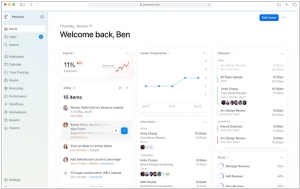Flowable vs jBPM
March 10, 2025 | Author: Michael Stromann
9★
Flowable offers a full-scale and extensible platform for the automation of business processes that combines the power of standards-based Case, Process, and Decision models to increase efficiency and productivity.
9★
jBPM is an open-source workflow engine written in Java that can execute business processes described in BPMN 2.0. jBPM is a toolkit for building business applications to help automate business processes and decisions.
Imagine, if you will, two highly intelligent and slightly quirky beings, each capable of managing the complexities of business processes, while occasionally pausing to enjoy a cup of tea. Flowable and jBPM are both open-source engines, comfortably able to define processes in the universally accepted BPMN 2.0 language, orchestrate workflows and automate tasks with the precision of a Vogon poetry recital. They are, in essence, two sides of the same coin, both equipped with the necessary tools to make your business run smoother, though one might argue that their respective approaches could be compared to the difference between flying a spaceship and taking a lift to the moon.
Now, Flowable, having made its grand debut in 2016, arose from the ashes of the Activiti project with an enthusiasm that could only be matched by an excited cat chasing a laser pointer. Developed by the good people at Flowable AB in Sweden, it’s designed with a strong emphasis on microservices, as if it’s anticipating the next wave of technology. It's the sleek, nimble creature of the BPM world—lightweight, flexible and with a penchant for APIs that make developers feel like they've just received an invitation to a secret party. Throw in some support for BPMN, CMMN and DMN and you have an engine that's as versatile as a towel in a galaxy far, far away.
On the other hand, jBPM, born in the early 2000s and now lovingly cared for by Red Hat in the United States, has all the gravitas of a seasoned professional. It’s like the wise old friend who’s seen it all—built on the mighty foundation of the JBoss community and capable of handling business rules with the skill of a well-read bookworm. It’s enterprise-grade, with a built-in decision management system that might just make you feel like you've discovered the answer to life, the universe and everything, all while tightly integrated into Red Hat's broader suite of tools. It’s solid, reliable and likely to be the engine you'd call upon when the going gets tough and you need a little more than just a cup of tea.
See also: Top 10 BPM Software
Now, Flowable, having made its grand debut in 2016, arose from the ashes of the Activiti project with an enthusiasm that could only be matched by an excited cat chasing a laser pointer. Developed by the good people at Flowable AB in Sweden, it’s designed with a strong emphasis on microservices, as if it’s anticipating the next wave of technology. It's the sleek, nimble creature of the BPM world—lightweight, flexible and with a penchant for APIs that make developers feel like they've just received an invitation to a secret party. Throw in some support for BPMN, CMMN and DMN and you have an engine that's as versatile as a towel in a galaxy far, far away.
On the other hand, jBPM, born in the early 2000s and now lovingly cared for by Red Hat in the United States, has all the gravitas of a seasoned professional. It’s like the wise old friend who’s seen it all—built on the mighty foundation of the JBoss community and capable of handling business rules with the skill of a well-read bookworm. It’s enterprise-grade, with a built-in decision management system that might just make you feel like you've discovered the answer to life, the universe and everything, all while tightly integrated into Red Hat's broader suite of tools. It’s solid, reliable and likely to be the engine you'd call upon when the going gets tough and you need a little more than just a cup of tea.
See also: Top 10 BPM Software





